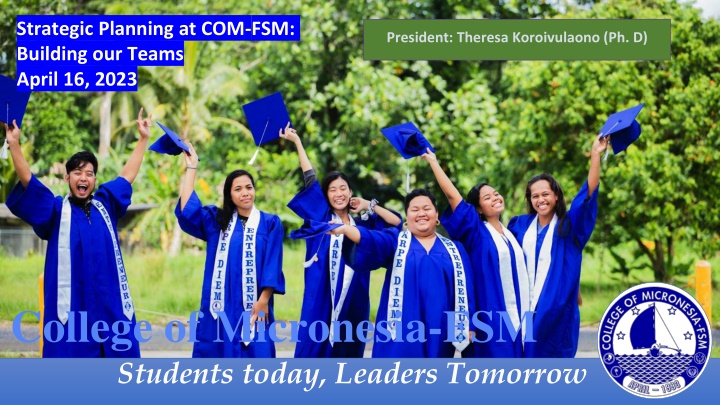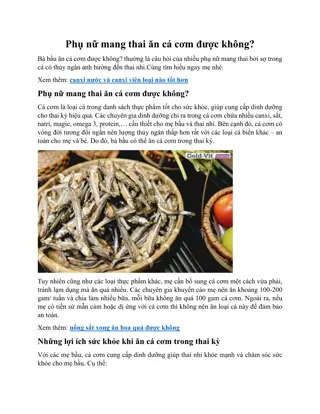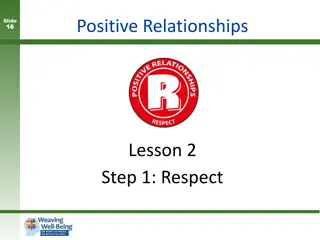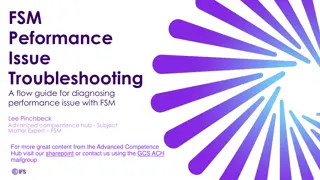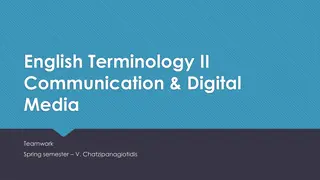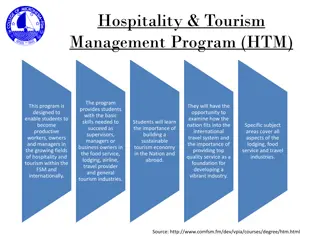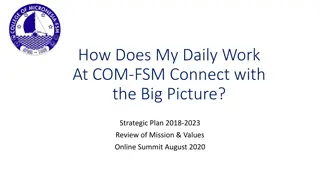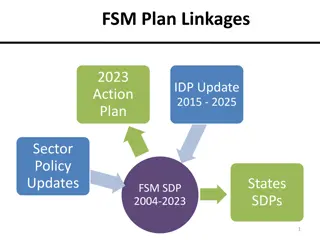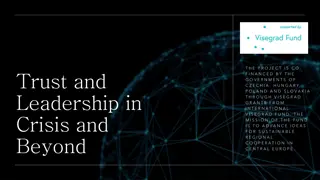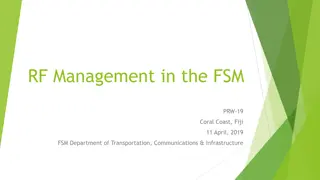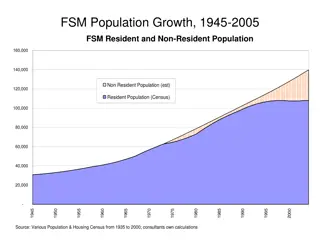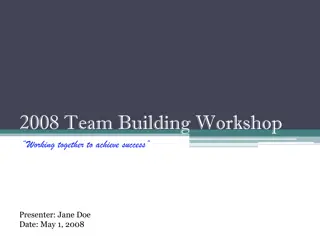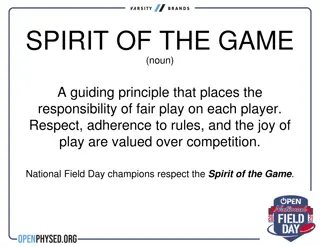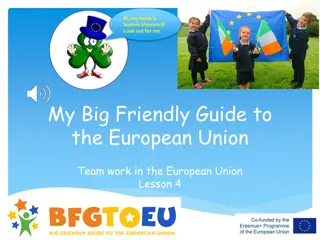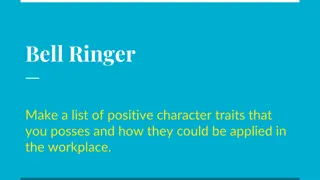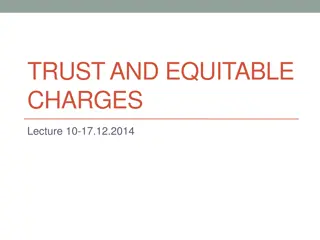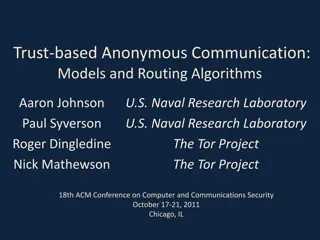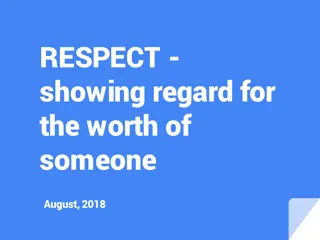Building Respect and Trust in Teamwork at COM-FSM
COM-FSM's emphasis on respect and trust in team building is evident in its strategic planning for developing leaders. The institution's mission centers on learner-centered education, fostering respect and continuous improvement. Understanding the significance of respect, the cultural values at COM-FSM emphasize roles, relationships, and community harmony. Explore the importance of respect, dealing with disrespectful behavior, and cultivating trust to enhance teamwork dynamics.
Download Presentation

Please find below an Image/Link to download the presentation.
The content on the website is provided AS IS for your information and personal use only. It may not be sold, licensed, or shared on other websites without obtaining consent from the author.If you encounter any issues during the download, it is possible that the publisher has removed the file from their server.
You are allowed to download the files provided on this website for personal or commercial use, subject to the condition that they are used lawfully. All files are the property of their respective owners.
The content on the website is provided AS IS for your information and personal use only. It may not be sold, licensed, or shared on other websites without obtaining consent from the author.
E N D
Presentation Transcript
Strategic Planning at COM-FSM: Building our Teams April 16, 2023 President: Theresa Koroivulaono (Ph. D) College of Micronesia-FSM Students today, Leaders Tomorrow
COM FSM MISSION STATEMENT The College of Micronesia-FSM is a learner- centered institution of higher education that is committed to the success of the Federated States of Micronesia by providing academic and career & technical educational programs characterized by continuous improvement and best practices.
Respect & Trust Mutual respect is a fundamental part of team building because it fosters productivity, trust, and loyalty. When they are treated with respect, each member of the team feels that they and their contributions are valued. The best way to earn respect is to give it. (Hire Road)
Our roles at COM-FSM The canoe culture is the focal point of the Chuukese Cultural Studies Program, for the canoe culture has the basic ingredients of the community, the one we ve moved away from. It surrounds the issues of respect - respecting everyone, and everything around you - elders, people you live with, the environment and our traditional practices. Respect for one another has been lost but on the canoe you must respect the navigator It s all about knowing your role in the community, your relationship to one another and respecting those things. http://chuukmicronesia.blogspot.com/2005/04/canoe-culture.html
What does RESPECT mean to you? List 3 things you expect from a colleague to show you respect. List 3 things you regard as disrespectful behavior from a colleague. How do you deal with disrespectful behavior? How do you think you can improve in this area?
Scenario 1 You are a crew member on the COM-FSM canoe about to set sail into the lagoon for a fishing journey. Your captain is younger than you and is a newcomer. The weather forecast is not favorable for later that day. The captain wants to push on and make the trip but you know that the conditions can change very quickly as you have lived here all your life. Share HOW you would advise the captain knowing that he is THE authority on the canoe but you have much more experience in the area.
Exemplifying TRUST Define trust in your work space. Give one example from your current portfolio to demonstrate your definition. How do you promote trust in your work space? Give one example from your current portfolio. How successful are you? Rate yourself from 1-10 with 10, equal to exceeding expectations . What would you do differently?
Scenario 2 Despite your advice not to take the fishing trip, the captain decides to set sail. He asks you to assist him given your knowledge and experience of the area. In order to ensure that the Captain can rely on your total commitment and cooperation, how would you respond? Share your strategy, communication and actions based on exemplifying your trustworthiness. Name one or two challenges that you would need to overcome so that you can contribute meaningfully, effectively and to engender the Captain s trust in you.
SMART Goals IEMP goals Support student success Meet workforce needs Enhance employment opportunities Build capacity Maintain accreditation. Source: https://www.playworks.ph/blog/2668168-setting-goals-for-2016-the-smart-way/
Steps to achieve the 5 IEMP goals Enhancing academic quality and program offerings to ensure student success for the next generation. Building facilities for the next quarter century by funding and implementing the ($68.84 M) Facilities Master Plan. Building endowment to the $10 million goal to support future programs & operations. Investing in the College s people to build capacity. Strengthening resources to meet current and future needs.
Why are goals important? So, goals are important. They help to pour a concrete solid foundation to our hopes and dreams, and the things that we want. They help to steer the [canoe] of our lives through stormy and choppy waters, across the channels of struggle, and onto the shores of accomplishment. We need goals in our lives, just as much as a captain needs a compass to navigate the high seas . Source: https://www.wanderlustworker.com/setting-s-m-a-r-t-e-r-goals-7-steps-to-achieving-any-goal/
Types of goals Goals should be high level enough to encompass the core outcomes for which you are responsible, but specific and clear enough so you will be able to measure success. Goals should be on-going job responsibilities and any new projects, assignments, priorities, or initiatives that are specific to this performance cycle. Having too many goals can be an indicator that your goals are scoped at too low a level and are focused more on tasks than on end results. If it seems that your goals are becoming too numerous and task- oriented, it may be helpful to consider combining several goal statements into a broader outcome area.
Specific In order for a goal to be effective, it needs to be specific. A specific goal answers questions like: What needs to be accomplished? Who s responsible for it? What steps need to be taken to achieve it? Thinking through these questions helps get to the heart of what you re aiming for. Here s an example of a specific goal for a company called Techfirm: Grow the number of monthly users of Techfirm s mobile app by optimizing our app-store listing and creating targeted social media campaigns. Source: https://www.atlassian.com/blog/productivity/how-to-write-smart-goals
Measurable What data will measure the goal? (How much, how well?) Techfirm s product team want to grow the number of their mobile app users but by how much? One new signup, is technically positive growth so does that mean they re done? The same goes for their strategy; how many platforms will they advertise on? Increase the number of monthly users of Techfirm s mobile app by 1,000 by optimizing our app-store listing and creating targeted social media campaigns for four social media platforms: Facebook, Twitter, Instagram, and LinkedIn. To make this SMART objective more impactful, the following measurable, track- able benchmarks are included.
Achievable Ask yourself: Is our objective something we can reasonably accomplish? Do we have the necessary skills and resources? If not, what needs to be amended to make the objective achievable? Amend the original objective. Increase the number of monthly users of Techfirm s mobile app by 1,000 by optimizing our app-store listing and creating targeted social media campaigns for three social media platforms: Facebook, Twitter, and Instagram.
Relevant Look at the big picture. How does the goal align with broader goals? Why is the result important? The app is a huge driver of customer loyalty, and that an uptick in app usage could mean big things for the company s bottom-line revenue goals. The statement is revised to reflect that context. Grow the number of monthly users of Techfirm s mobile app by 1,000 by optimizing our app-store listing and creating targeted social media campaigns for three social media platforms: Facebook, Twitter, and Instagram. Because mobile users tend to use our product longer, growing our app usage will ultimately increase profitability.
Time-bound To properly measure success, you and your team need to be on the same page about when a goal has been reached. What is the time frame for accomplishing the goal? When will the team start creating and implementing the tasks they ve identified? Grow the number of monthly users of Techfirm s mobile app by 1,000 within Q1 of 2022. This will be accomplished by optimizing our app-store listing and creating targeted social media campaigns, which will begin running in February 2022, on three social media platforms: Facebook, Twitter, and Instagram. Since mobile is our primary point of conversion for paid-customer signups, growing our app usage will ultimately increase sales. SMART goals should have time-related parameters built in, so everybody knows how to stay on track within a designated time frame. Incorporating these dates, completes the SMART goal.
Breakout session 1: Identifying departmental goals 20 minutes 1. Identify 3 goals for the SLT. 2. Why did you choose these ones? (Why not others?) 3. Show the relationship between the goals and your core responsibilities as senior leaders. 4. Use a PPT to present your answers to questions 1- 3 above.
SWOT stands for Strengths Weaknesses Opportunities Threats
Strengths Abilities & Skills Experience Knowledge Resources
Weaknesses Resources needed Skills/Abilities needed Contacts/Partners needed Limitations
Opportunities Positive trends Support Networking Training available Technology
Threats Risks Change in circumstances Obstacles
Breakout session 2: SWOT ANALYSING OUR SLT 20 mins 1. Divide into 2 groups. 2. Work on each quadrant of the SWOT analysis diagram. - Fill in the spaces in relation to our responsibilities as senior leaders. - What are the priority areas? - Name the major risks? - How do you mitigate the risks? 3. Revisit your goals. Align the goals with the SWOT Analysis. 4. Share this output with the workshop group. 5. Save a copy for our strategic planning sessions.
Themes & Components Learning experiences; Board Governance Plan; Human resources; Financial management; Enrollment management and student services & Security Information Technology; Research and Community Outreach; and Facilities and Maintenance. Learner-centeredness Continuous improvement Best practices
COM-FSM INTERGRATED PLANNING FRAMEWORK MISSION INTEGRATED EDUCATION MASTER PLAN STRATEGIC PLAN LEARNING EXPERIENCES ENROLLMENT MANAGEMENT, STUDENT SERVICES & SECURITY BOARD GOVERNANCE PLAN HUMAN RESOURCES INFORMATION TECHNOLOGY RESEARCH & COMMUNITY OUTREACH FINANCIAL MANAGEMENT FACILITIES & MAINTENANCE KEY PERFORMANCE INDICATORS
References Chuuk Micronesia. Society for Historical Investigation and Preservation. April 12, 2005. http://chuukmicronesia.blogspot.com/2005/04/canoe-culture.html Hire Road. 2023. https://hireroad.com/resources/thriving-teams-7-elements-for- success#:~:text=Mutual%20respect%20is%20a%20fundamental,respect%20is%20to %20give%20it.
